Table of Contents
Crinum Calamistratum Care
Crinum calamistratum thrives in huge tanks. You should carefully set the tank up to ensure this plant thrives well. It is recommended that any leaves on the stalk’s outer layer be removed to prepare it for planting. If any leaves are clipped too short, it’s preferable to take them off because they’re dead and won’t help the plant.
Crinum Calamistratum Overview
Crinum calamistratum is an ideal aquarium plant; it is one of the most unique looking aquatic plants you can use as a background plant and for several other decoration purposes. Its appearance resembles that of an onion bulb-like structure. Most aquarists keep this plant to enhance the look of their aquariums and add a spotlight look to the aquarium tank.
Crinum calamistratum grows underwater and has long, slender leaves above the waterline, up to 4 feet long.
The dark green color leaves give Crinum calamistratum the most elegant picturesque look. Though the leaves are wrinkled, long, spiral, spindle-like, and curly, these plants move and grow upwards. Their leaves almost look like tentacles that hang over once crossing the waterline.

The Crinum calamistratum, when planted in an aquarium setting, increases the enjoyable aspects of the aquascape by adding elegant aesthetics to the tank. Once planted under good quality water, it has the potential to grow brightly white-colored flowers as well. It also thrives in brief dry spell periods.
proper supplementation of CO₂| Information Chart | Crinum Calamistratum |
|---|---|
| Scientific Name: | Crinum Calamistratum |
| Family: | Amaryllidaceae |
| Care Level: | Easy to Moderate |
| Growth Rate: | Slow |
| Maximum Size: | 36-48 inches (91-122 cm) |
| Minimum Tank Size: | Medium to large |
| Water Conditions: | Temperature: 68-82°F (20-28°C)pH: 6.1–7.9Hardness: up to 18 dGH |
| Lighting: | Medium |
| Propagation: | Bulb shoots |
| Placement: | Background |
The Appearance Of Crinum Calamistratum
The plant features a very elegant look and often brings an esthetical aura when added to an aquarium. When grown in ideal conditions, it exhibits stalks that are long, spiral, and spindle-like. The plant’s leaves are usually green, appearing somewhat wrinkled, and if you are a novice, you may mistake this for nutritional deficiency.
The plant’s unique feature of having stalks that are curly and tentacle-like can make you think that water waves have swept it. The stalks of the plant are thin and long and will easily move about in the direction of the water current. With these unique and interesting looks, the plant has become so popular amongst aquarists who wish to add oomph to their aquascapes.
Native Habitat And Origin
This bulbous plant originates from the family of Amaryllidaceae, specifically situated in the West/Central African region in Cameroon. The plant usually stays fully submerged in water when growing in the wild, and therefore even if you are taking it to grow it in your aquarium, it is best to let it grow under the same conditions.
Crinum Calamistratum Care and Tank Set-Up
To ensure this plant thrives well, you should carefully set the tank up. Despite the small leaves, this plant takes up a lot of room since the leaves spread out in all directions.
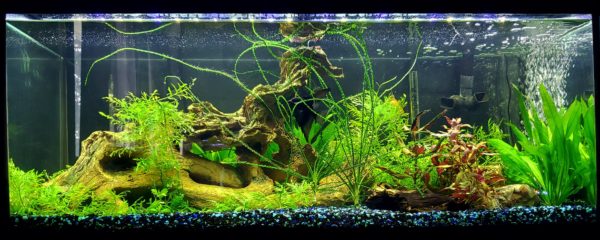
Crinum Calamistratum Tank Size and Specifications
Tank Size For Crinum calamistratum
Crinum calamistratum thrives in huge tanks because of this. It is recommended that any leaves on the stalk’s outer layer be removed to prepare it for planting. If any leaves are clipped too short, it’s preferable to take them off because they’re dead and won’t help the plant.
Easily break the leaflets downward until a new white stalk emerges. These extra layers will wither and go off the plant, so this won’t cause any problem.
Substrate
Crinum calamistratum should be planted in a fine gravel substrate. It should be grown in a sand-based substrate that isn’t too thick or heavy. Because they are big root feeders, providing ample nutrients in the substrate will aid in the plant’s health. Medium to high levels of aquarium illumination is required for this plant.
Lighting
Lighting is vital if you want your Crinum calamistratum to grow tall and bloom with flowers. Planting in soil substrate is another approach to making your plant blossom. The plant will grow and flourish at somewhat higher light levels. Your plant will also look fantastic with illuminated water flow.
Crinum calamistratum has large, thick leaves. Most fishes cannot eat through the leaves and damage the plant because of their thickness. Giant mystery snails make excellent tank companions for this plant. They adore consuming any red patches or deterioration on your plant. Snails will keep your plants looking good and healthy while preventing decay from remaining on them.
Water Parameters for Crinum Calamistratum
Please note that propagating this plant from seeds is not easy and is something that only experts can do.
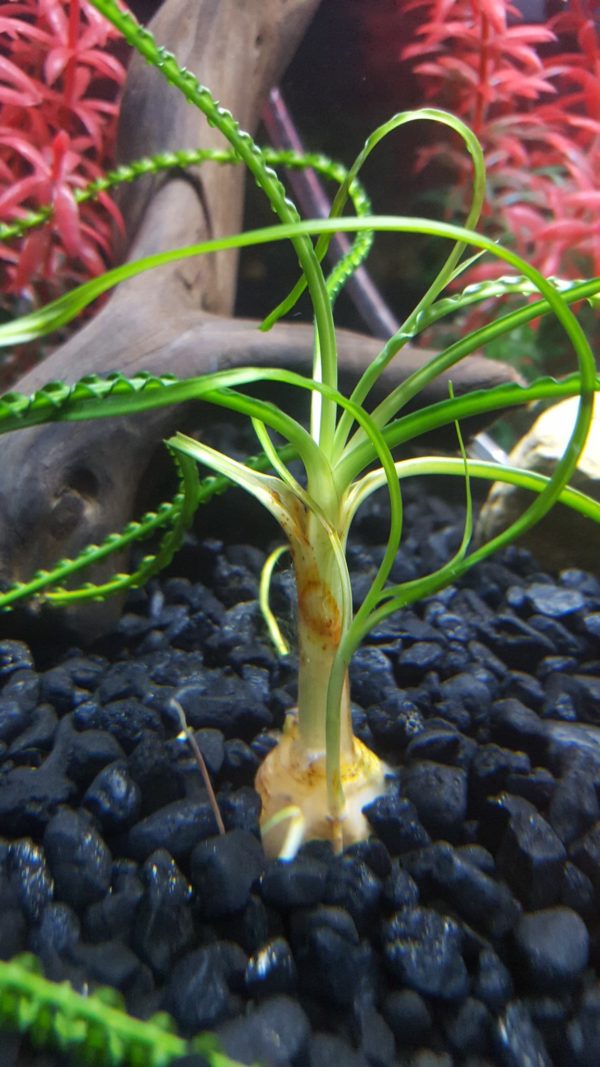
Water Hardness
The recommended water hardness for growing the plant should be dGH 0 – 18°N (321.43ppm).
Water Temperature
The recommended temperature for growing the plant in an aquarium setting should be 20 – 27°C.
Water pH
The pH range of the aquarium water should be 6.1 – 7.8, and the substrate should be fine gravel.
Cultivation/Propagation
The Crinum Calamistratum plant does not require many maintenance needs once planted in the aquarium. However, it must be noted that the plant usually doesn’t do well when transplanted. It is one plant that you will not just uproot and then proceed to plant into the substrate and expect it to do well.
Crinum Calamistratum Planting Instructions
Crinum calamistratum might be sensitive during the transplanting procedure despite its hardness and toughness. When it is frequently transplanted, it fails to thrive. Choose a permanent place for the Crinum calamistratum in the tank to avoid moving the plant several times.
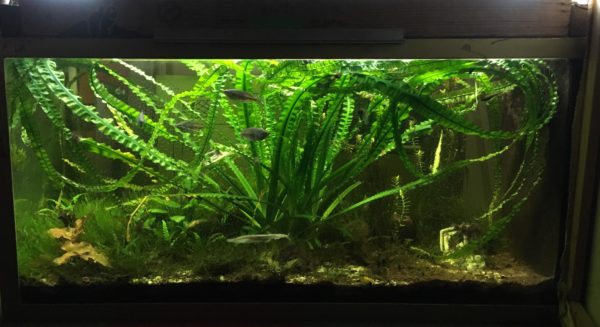
Crinum calamistratum is a striking plant that works well in all tank areas, including the front, middle, and background. However, because the plant tends to be so tall, it is usually placed near the back of the tank.
As a result, most aquascapers regard this plant as a background plant. Ensure that this plant gets enough light and nutrients, regardless of where you put it.
Crinum calamistratum is a slow-growing plant in general. Supplementing with CO2 is critical if you wish to accelerate your growth. It is unnecessary to add No products found. to the tank for the plant to survive. It does, however, assist the plant in remaining healthy and growing at a faster rate.
When your Crinum calamistratum is ready to be planted, carefully insert it into the substrate. Only 2/3 of the bulb should be buried beneath the substrate, and the remaining 1/3 of the tank should be visible.
The plant will wither, and the roots will rot if the entire bulb is planted underneath the substrate. As long as the roots are beneath the substrate, this plant can thrive when placed directly on the substrate.
It’s normal for the plant’s structure to emerge from the substrate, and that’s great. Keep in mind that this plant does not do well after the transfer, so you’ll need to make sure you have the right tank and water for it to adjust. The Crinum calamistratum does remarkably well on its own once it has established itself in the tank and will develop without difficulty.
Crinum Calamistratum Propagation & Pruning
Let us now discuss the Crinum calamistratum’s proliferation and pruning. Crinum calamistratum sprouts from the sides of the mother bulb and grows by buds. New shoots emerge from the bulbs.
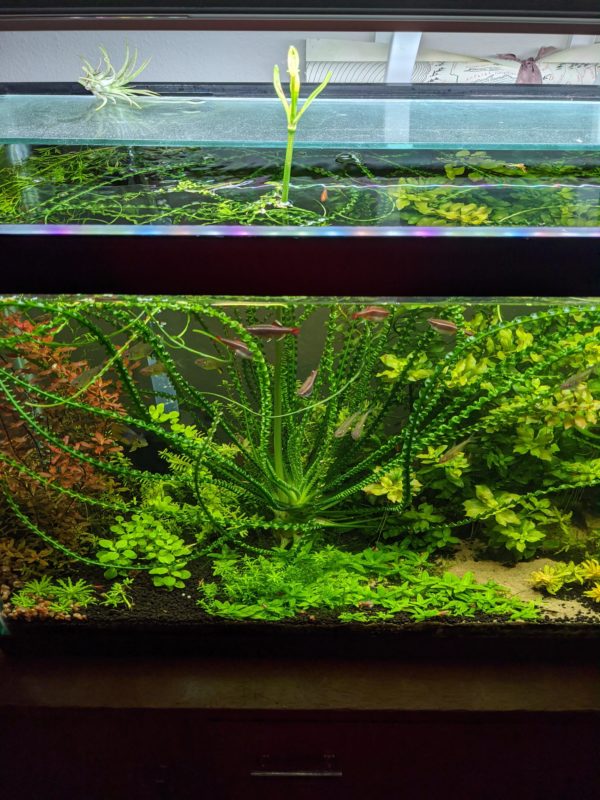
Remove the bulbs with care. Into the substrate, place the buds. Each bud will develop into a separate plant over time. Aside from the plant’s fundamental requirements, adding fertilizers to the substrate to encourage development would be beneficial. Crinum calamistratum seeds can also be used to propagate it. Seed propagation is, however, more difficult than bulb propagation for this plant.
If your Crinum calamistratum is expanding rapidly and has a lot of leaves, now might be the time to prune it. You can no longer cut the leaves like hair. The leaves will decay if you do this. Trim the leaves near the bulb’s source to keep them from rotting.
Crinum calamistratum piques the interest of the vast majority of persons who come across it. This African Onion Plant is a popular choice among aquarists looking for a modernistic plant to add to their tank due to its distinct appearance. Their long green leaves swirl when the water current flows through them.
They get along with various plants and species, making them ideal for community aquariums. However, Crinum calamistratum is not widely available, so you may have to look for it.
Growing Conditions for Crinum Calamistratum
The plant’s growth is usually slow, and it remains fully submerged in water. It is best not to mix this plant with fish that frequently nip on its leaves, adversely affecting its overall growth rate. It can do well in both soft and hard water. Plants growing in mildly salty and freshwater are observed to be successful.
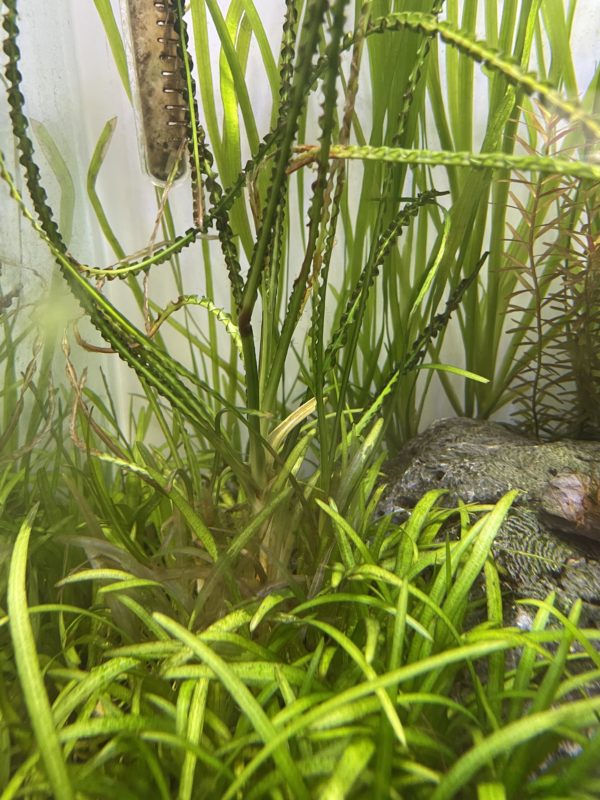
Crinum Calamistratum Plant Features
Grows are submerged in water, and when flowering, the flowers become beautiful and usually get suspended high enough on stalks above the water surface. The leaves are dark green and usually grow upward at a slight angle from the bulb and will exhibit curls and loops. It can grow to lengths of up to 4 feet high.
Aquarium Use Of Crinum Calamistratum
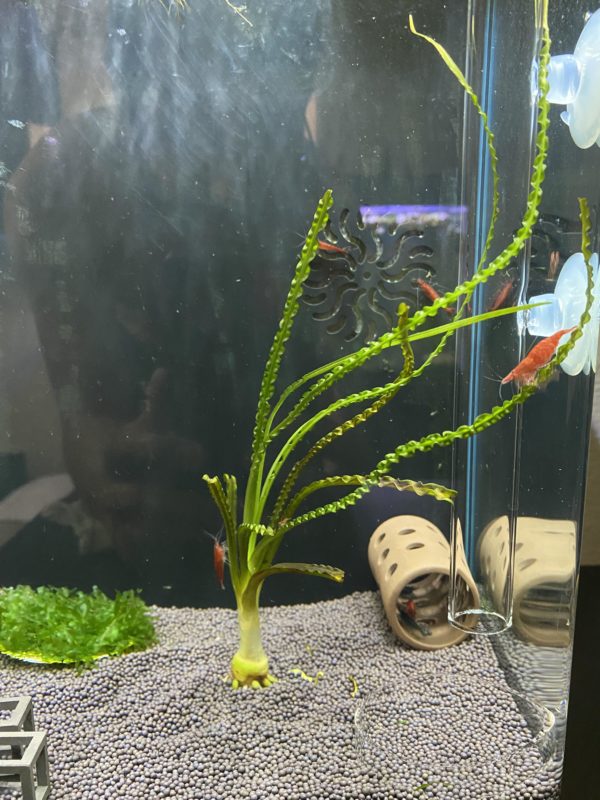
The plant is best placed in the midsections or the back of the tank to offer a strong focal point. Indeed you can use it in the aquarium to make additions to the beauty of the tank. However, it is best to be mindful of the position that one should place in the tank regarding light. Remember, the plant requires sufficient light to do well and bloom its elegant flowers. Allow the plant to establish itself either in the mid or background-position without frequent interference. Please remember to place the plant in a position within the tank where it will receive enough light.
Which Fishes Are Best Suited For Crinum Calamistratum?
From the above, you know how this plant thrives in the aquarium. As we mentioned earlier, Giant mystery snails are one of the best companions for Crinum Calamistratum. However, if you are willing to add more life to your aquarium, you can go for one of the fishes we listed below.
The aquarium’s focal point, the mid-level, should be densely packed with active fish. Schooling fish, including most Tetra species and some Barbs, are ideal for the medium level of a large tank. Dither fish, especially schools of energetic fish, are frequently chosen as dither fish for cichlid aquariums.
Gouramis, Rainbowfish, and Angelfish are larger fish that make good mid-level fish. It’s crucial to keep in mind that slower-moving fish with long-flowing fins may be preyed upon by smaller, faster-moving species.
Tiger Barbs are notorious for nibbling fins in particular. You should not mix them with Angelfish or Bettas. Also, consider that many Gouramis aren’t tolerant of their species, so do your research before introducing them.
1. Black Widow Tetras
Why is Black Widow Tetra suitable for Crinum Calamistratum?
Black widow spiders are a low-maintenance species that may thrive in various environments, though they prefer dim illumination and neutral-colored gravel surfaces. They are used to huge plants in their natural habitat and thrive in a well-designed aquarium with plenty of open swimming rooms.
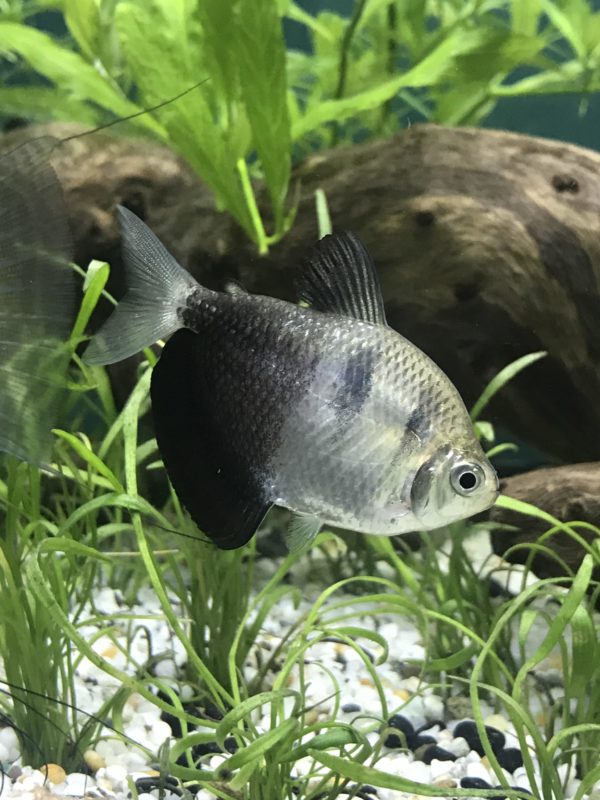
They thrive in a temperature range of 68-78 F within a pH of 6-7 and a hardness of 5-20 H, which aligns very well with Crinum Calamistratum requirements. However, unlike this plant, it generally lives in dim conditions. One can overcome this by planting dense plants at midground, habilitating these tetras.
How Many Black Widow Tetras You May Need?
Black widow tetras prefer to be kept in groups of six or more because they are naturally schooling fish. Because of their gentle demeanor, they make great community fish. According to some, slave-moving fish, especially those with long, flowing fins like bettas or angelfish, are sometimes nipped by their owners.
Would They Nibble on the Leaves of Crinum Calamistratum?
The leaves of Crinum Calamistratum aren’t chewable to this fish. Thus, it can supplement their diet. However, live, fresh, cold, freeze-dried, or flake foods are all acceptable to black widow tetras. Provide a variety of diets, such as high-quality flake foods, brine shrimp, any form of worms, vegetable supplements, and spirulina, to ensure the breed’s ideal health.
2. Glassfish
Why are Glassfish suitable for Crinum Calamistratum?
Glassfish are a little species that only reach about 3 inches. It does not, however, negate the requirement for a large tank. The tank should be no smaller than 10 to 20 gallons as a general guideline, but the exact size will depend on the other occupants and the quantity of Glassfish in it.
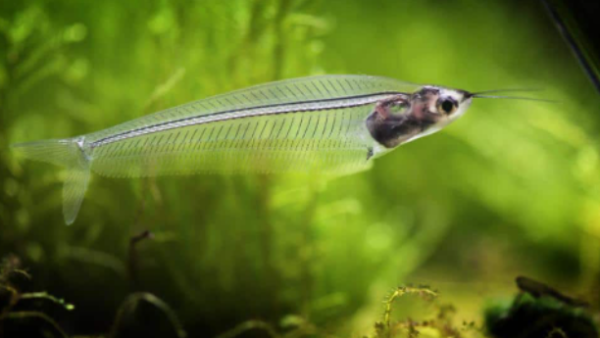
Freshwater, mildly acidic to moderately alkaline with a pH of 6.5 to 7.5, should be used in the tank. They become drowsy in brackish water, which is unsuitable for their living conditions.
GlassFish likes big freshwater tanks with plenty of open areas for swimming (they’re quick and playful swimmers) and dense flora and rocks that resemble their natural habitat. Because of their origin, these fish also require a water temperature of 68° to 86° Fahrenheit to survive.
How Many Glassfish You May Need?
There are a lot of tank mates you can add to your aquarium if you are going for Glassfish. In groups of 5 or more, they’d probably make good dither fish. It would also be an excellent “target” fish for species that become hostile during mating season. They can swim quite quickly and appear to be playful.
Stay away from picking the predators that are large enough to consume them. Aggressive tank mates may not be ideal, but they may thrive in a tank with semi-aggressive fish with plenty of hiding spots.
Do They Thrive On Plants?
They are carnivorous and thrive on bloodworms and flakes. However, make sure you do not give them dry food as it doesn’t suit them well.
3. Mollies
Why Are Mollies Suitable For Crinum Calamistratum?
Mollies have a wide range of varieties. And almost all of them thrive in the following conditions, which align very much with Crinum Calamistratum:
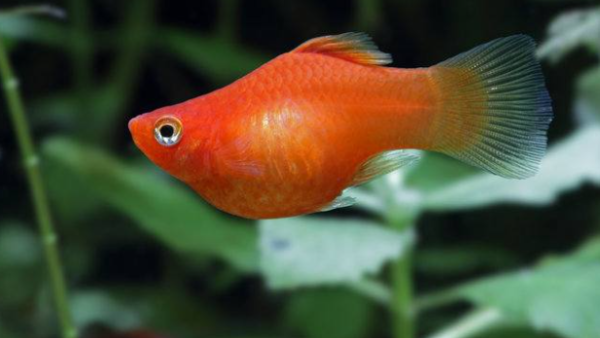
Water temperature: 72°F to 78°F (Crinum: 68°F to 80°F)
Water Hardness: 20-30 kH (Crinum: up to 18 dGH)
pH: 7.5 to 8.5 (Crinum: 6.1 to 7.8)
*Consult a fish expert who can help you find the right kind of Molly fish for your needs.
How Many Mollies Do You Need To Keep In Your Aquarium?
Mollies live in schools, and you need to keep them in a group of four (at least) to avoid fatalities due to loneliness and anxiety.
If you want to make a multi-species community tank, you have a variety of alternatives. Mollies get along with almost everyone!
Mollies won’t have any issues living with them as long as the other tank mates are quiet.
Avoid any fish that has a reputation for being hostile. Also, try to keep fish of the same size. Larger fish may try to bully or eat your molly.
Do Mollies Feed On Other Fishes And Live Plants?
Mollies are almost entirely leaf and algae eaters in nature. Therefore they require a lot of spirulina, even finely chopped cooked spinach, to stay healthy. However, Crinums leaves can be hard to nibble on them. Thus, your plant will be safe.
If your tank lacks algae, you’ll need to supplement with “spirulina” flakes, commercial Mollie food, or tiny quantities of chopped boiled spinach. They like to graze on the algae bloom in the tank and will graze on it indefinitely, looking for tasty areas to chew on.
4. Emperor Tetra
Why Is Emperor Tetra Suitable For Crinum Calamistratum?
Emperors prefer lush vegetation and dim lighting, which resembles the Colombian rivers from where they emerge.
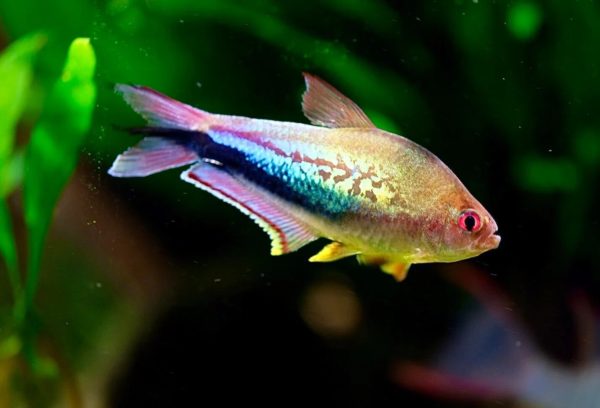
Just like in the case of Black Widow Tetras, you can add dense plants in the mid and foreground to create a dim lighting situation.
A dark substrate and a densely vegetated tank will help them feel at ease and provide a stunning backdrop for this species’ vibrant colors.
Even though peat filtering is advised, they can grow in even somewhat hard water if it is changed regularly enough to preserve purity. These fish love quiet environments and should only be housed with other tranquil species that require equal amounts of water.
How Many Emperor Tetras Can You Put In The Tank?
The emperor tetra is a schooling fish that thrives in groups of five or six with a dominant alpha male. However, it can also survive in pairs. It is also a quiet fish, perfect for a small community tank, though more raucous species will disturb it.
Danios, rasboras, other tetras, and gentle catfish species like Corydoras or smaller Loricariids are compatible species.
Pencil fish and dwarf cichlids are other fantastic options, especially since they both come from the same region. To produce a pleasing palette, consider species that visually contrast with the colorful emperor tetra.
Are Emperor Tetras High Maintenance In Terms Of Diet And Food?
The emperor tetra eats worms and crustaceans in the wild. Captive emperor tetras aren’t fussy about their food and will eat flake, freeze-dried meals, and frozen foods without hesitation. Daphnia, mosquito larvae, and brine shrimp are popular live meals that are great for training breeding couples.
5. Head And Tail Light Tetra
Are Head Light Tetras A Good Choice For Crinum Calamistratum?
Like the lack Widow and Emperor Tetra, HeadLight Tetra thrives in similar conditions and is another suitable option for Crinum Calamistratum. Moreover, their appearance is unique, which will stand out in your tank.
Arrange a biotope aquarium with real or imitation plants to see this small tetra sparkle. Shade is provided by floating or tall plants that reach the top of the tank, which is especially ideal for this fish, which enjoys shaded areas.
To help simulate dark water conditions, place a small net bag packed with aquarium-safe peat in the filter. To finish the optimal tank setup, leave some free-swimming room in the center.
How Many Head Light Tetras Do You Need To Add To Your Tank?
Head and tail light tetras do best in six or even more groups and can be maintained with other calm fishes, particularly tetras. Barbs, danios, rasboras, and other tranquil tiny to medium-sized fish are wonderful companions. Small loaches, catfish, dwarf cichlids, and gouramis are good options.
Fish that are big enough to devour tetras should be avoided. Also, slow-moving, long-finned species like angelfish and bettas can be nipped at the fins by head and tail light tetras.
Are Head Light Tetras Difficult To Keep?
Absolutely no. The head and tail light tetra is an omnivore that eats various foods. However, it won’t eat live plants. Provide a wide range of flake meals and freeze-dried or frozen live foods, including brine shrimp, bloodworms, and minute insects. They’ll also eat fine pelleted food.
How To Keep Your Aquatic Greens in Pink Of Their health?
It’s not uncommon for aquatic plants to fade in health with time. The keeper should practice the following maintenance tips to keep their Crinum and other plants in good health to avoid such situations.
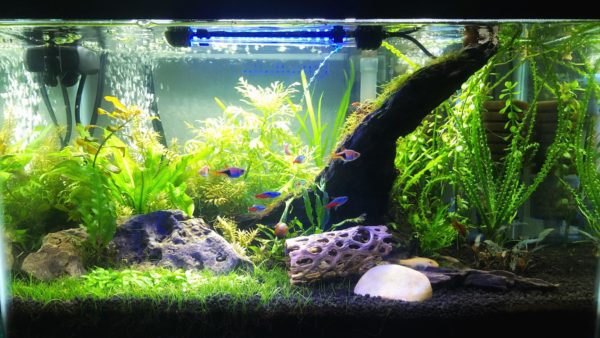
Daily Care
1. Use liquid carbon and dosing fertilizers. If you don’t get your daily dose of liquid carbon, your plants won’t get a constant supply of carbon. Algal growth might be exacerbated by fluctuating levels.
2. Remove any leaves that are dead or rotting. Their decomposition will encourage the growth of algae.
3. Check the temperature of your water. Any problems with your heater could result in a drop in temperature, which could be harmful to fish and plants, especially during the winter.
4. Clean the aquarium glass and, if necessary, top up the water level.
Weekly Care
1. Every week, perform a minimum 30 percent water change. It reduces the accumulation of organic waste, which algae feed on. Until your tank grows, you should change the water more frequently during the first 2-4 weeks. 2-3 times per week will reduce the likelihood of algae outbreaks during your aquarium’s most vulnerable stages.
After your tank has matured, you should limit the number of times you change water each week.
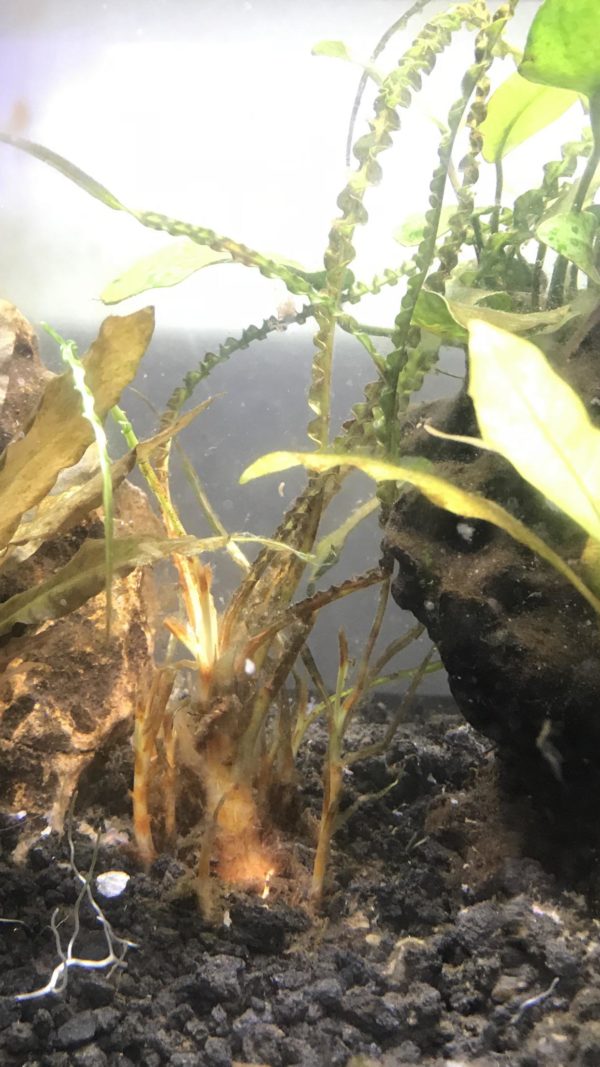
2. Make sure your aquarium’s equipment is in good operating order (heater, filter, light timer, CO2 equipment, etc.). Any flaws in your planted aquarium can cause it to become unstable.
3. Glass, hardscape, and plant leaves should all be clean. If you have a lot of algae, you should carefully consider lowering your lights, checking your CO2 levels, and increasing your water changes. Cleaning the algae tank is simply a temporary fix; the long-term cure is to eliminate the algae source.
4. Use your plant scissors to trim your plants. Trim plants regularly to encourage desirable development and keep them from becoming out of control. It’s also your chance to be creative and create a beautiful planted aquarium! Remove the lowest leaves from any cuttings, clip the roots, and replant them into your substrate.
Monthly Care
1. Make sure your filters are clean. Clean your filter media thoroughly; it’s best to do this in aquarium water that has been removed during a water change. Cleaning your filter will eliminate organic debris that has accumulated over time. Don’t worry about killing your filter’s helpful bacteria; there will be sufficient left to deal with your tank’s natural ecosystem.
2. Clean your tank’s pipes, lily pipes, and other equipment inside and outside. It’s all about the presentation!
Conclusion
Crinum Calamistratum is a good aquarium favorite plant that is ideal for placing in the midsection or the background of the aquarium. It does best when exposed to bright light and sufficient carbon dioxide. The plant grows best in soft or slightly brackish water and puts forth bright young flowers contributing to the overall elegance of your aquarium.
No related posts.
